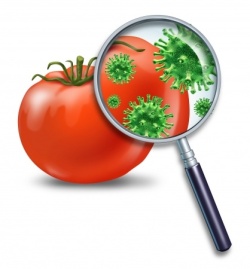
An article in the Telegraph on 21st October reported the development of a handheld bio sensing device that would scan food for the presence of bacteria to prevent food poisoning.
How was this story reported?
The Telegraph story (see text at the bottom of this piece) was briefly covered on page 3 and mentions very little of the science behind the system. Instead the article focuses very much on the impacts and causes of food poisoning, relating this discovery to the effect it could have on saving lives and preventing illness. Other reporting on the internet (story 1; story 2) gives more details about how the system actually works. However, while they mention the need to add sensors to the food the text implies this is no longer the case with the development of the handheld sensor. Many of these articles are identical, lifting text directly from the press release. This shows how important an accurate press release is in determining the quality of the reported story.
So how does this device actually work?
As the article states the biosensor is a magnetoelastic sensor. Magnetoelastic materials vibrate strongly at a particular frequency when excited by an oscillating magnetic field.
Grimes, CA, Roy, SC, Rani, S and Cai, Q (2011). Theory, Instrumentation and Applications of Magnetoelastic Resonance Sensors: A Review. Sensors (Basel), 11, 2809–2844. doi: 10.3390/s110302809
This frequency is a resonance frequency, like when you push a swing in time with its natural swing it goes higher and higher. For magnetoelastic sensors, changing the mass, e.g. by bacteria binding to the surface, shifts the resonance frequency. If the surface is coated with chemicals (e.g. antibodies) that specifically only bind the bacteria of interest, in this case the food poisoning causing Salmonella, then detecting a shift in resonance frequency implies that these bacteria are present in the sample.
The published journal article on which the story is based describes the redesign of the sensor measurement system. Previously, most other systems using magnetoelastic sensors performed the detection inside a large coil, which made analysing samples outside the lab quite tricky.
Although a commercial system with external detection (i.e. without the large coil) is available, accurate positioning of the sensor is necessary to achieve reliable detection. What the scientists from Auburn University have achieved is to increase the sensitivity of the external detection approach allowing them to pick up sufficient signal with a handheld scanning device.
Both the press release from Auburn University and the Telegraph article imply that the device is capable of picking up potential food poisoning causing bacteria in any food samples merely by sweeping it over the food.
However, in order for the system to work, magnetoelastic sensors will first have to be added to the food. Additionally, any bacteria would need to be bound to the sensor surface in order to be detected. So one challenge with using this system will be deciding how many sensors to add and trying to evenly distribute them throughout the food to maximise the likelihood of adding them just where the bacteria are.
Another problem will then be removal of the sensors, which are about the size of a grain of sand. So far the system has been trialled with tomatoes and watermelons. Addition and removal of sensors from the outer smooth surfaces of fruit is likely to be a lot simpler than from a plate of curry for example.
There is also no indication in the Telegraph story of how sensitive the system is. Actually, the original research paper shows that it is possible to detect 15,000 Salmonella cells. However, the infectious dose of Salmonella is lower than this, so the system is probably not yet sensitive enough to detect all at-risk food samples.
The system will also need to be extended to detect other bacteria which can cause food poisoning, by using different recognition chemicals on the sensor surfaces. With all these extra developments needed, it’ll be a while yet until you can easily check how safe your dinner is.
Original Telegraph article text:
Scientists have developed a hand-held scanner that can detect whether a meal contains traces of bacteria to prevent diners suffering from food poisoning. The new biosensing system can be passed over food before it is served to determine if its surface is contaminated with bacteria or viruses.
The Government has estimated that each year in the UK around a million people suffer from a food-borne illness, resulting in 20,000 being taken to hospital and 500 deaths.
Food poisoning is caused by bacteria, such as Salmonella or E. coli, or a virus, such as the norovirus. It happens when certain foods are not handled, stored or cooked properly.
The American Institute of Physics’ Journal of Applied Physics has published a study by scientists from Auburn University, who recognised the need for a real-time biosensing system to detect pathogenic bacteria. Food poisoning spreads quickly, and past detection systems have been slow. The researchers have filed a patent for their magneto-elastic biosensing system.
Chai, Y, Wikle, HC, Wang, Z, Horikawa, S, Best, S, Cheng, Z, Dyer, DF & Chin, BA (2013). Design of a surface-scanning coil detector for direct bacteria detection on food surfaces using a magnetoelastic biosensor. Journal of Applied Physics, 114, 104504. doi: 10.1063/1.4821025
From → Biomedical, News Stories


milk, custard and previously prepared meat dishes are the chief sources. Most causes are due to some strain of staphylococci which produce a heat stable enterotoxin.